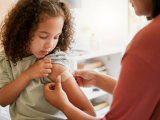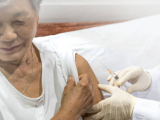Aug 17, 2011 (CIDRAP News) – Scientists have found an answer to a nagging question about how best to protect children under age 3 against influenza, reporting that any combination of injected or nasal-spray vaccines, given in any order, yields similar protective antibody responses in the recommended two-dose prime-boost strategy.
The multicenter study, conducted at National Institute of Allergy and Infectious Diseases (NIAID) centers in Saint Louis, Nashville, and Cincinnati, also found that the spray vaccine, known as live attenuated influenza vaccine (LAIV) (FluMist), stimulated a broad array of T cells, which may help protect against diverse flu strains.
Experts typically recommended that children ages 6 months to 3 years, the youngest age-group recommended to receive the flu vaccine, be immunized with two doses of the same vaccine formulation given 1 month apart, because different combinations had not been studied before. Dosing issues sometimes arise when flu vaccine supplies are scarce or uneven, such as during the first few months of the 2009 H1N1 vaccination campaign, or when patients or their parents prefer one formulation over another.
The findings were published online yesterday in the Journal of Infectious Diseases.
NIAID Director Anthony S. Fauci, MD, noted in a statement yesterday that complications from seasonal flu can be devastating in young children. "This study provides initial evidence that the prime and booster doses for these young children can be different types of flu vaccines and still provide adequate protection against matching seasonal flu strains," he said.
The researchers conducted the trial during the 2005-06 and 2006-07 flu seasons. It included 53 children ages 6 to 35 months, none of whom had been vaccinated against flu before. The children were divided into four groups; each group received either two injections of trivalent inactivated vaccine (TIV), two LAIV nasal-spray doses, or a combination of the vaccines given in two different orders.
Researchers obtained throat and nose swabs to culture for vaccine and wild-type viruses. They also obtained serum samples at baseline, at day 30 before the second dose was given, and at day 60. The team used hemagglutination inhibition testing to measure influenza-specific antibodies and flow cytometric and functional assays to study T cells.
After comparing hemagglutination inhibition responses among the four groups, investigators found that all four dosing patterns were safe and induced similar levels of protective antibodies. However, when they looked at T-cell responses, they couldn't find any influenza-specific ones in the children who received two TIV doses. Tests revealed that youngsters who received at least one LAIV dose produced significant amounts of three T-cell subtypes that are likely to provide additional protection.
In a separate in vitro arm of the study, the group found that LAIV, but not TIV, induced T cells that recognize genetic sequences shared by a diverse group of flu viruses.
When they examined postvaccination shedding of LAIV viruses, the authors found shedding in 17 (61%) of 28 children after the first dose, but shedding after the second dose occurred in only 1 (8%) of 13 children who received two doses. Though TIV priming yielded a trend of protection against LAIV shedding following a booster LAIV dose, the effect wasn't statistically significant.
Children who received only one dose of LAIV had similar T-cell responses to those in subjects who received two LAIV doses, the researchers found.
Daniel F. Hoft, MD, PhD, an infectious disease specialist with the NIAID unit at Saint Louis University who is the first author of the study, said in the statement that this particular LAIV T-cell finding may have important clinical implications. Because LAIV has sometimes been linked to increased incidence of wheezing in the youngest children, the best strategy for kids younger than 24 months may be TIV followed by LAIV, he said. However, the authors emphasized that larger clinical studies are needed to confirm the safety and efficacy of that approach.
Hoft said earlier studies have shown that children are better protected against flu by LAIV than by TIV, but few have explored T-cell responses to LAIV in very young children who had little earlier exposure to flu. He added that because the children in the trial were all younger than 3, researchers are confident that the increases in three T-cell subtypes that they detected were likely the result of vaccination.
Hoft DF, Babusis E, Worku S, et al. Live and inactivated influenza vaccines induce similar humoral responses, but only live vaccines induce diverse T-cell responses in young children. J Infect Dis 2011 Aug 15; early online publication[Abstract]
See also:
Aug 16 NIAID news release




















